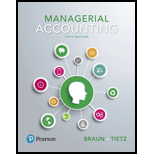
Sustainability and
SUSTAINABILITY
Sandler Industries manufactures plastic bottles for the food industry. On average, Sandler pays $72 per ton for its plastics. Sandler’s waste-disposal company has increased its waste-disposal charge to $54 per ton for solid and inert waste. Sandler generates a total of 500 tons of waste per month.
Sandler’s managers have been evaluating the production processes for areas to cut waste. In the process of making plastic bottles, a certain amount of machine “drool” occurs.
Machine drool is the excess plastic that drips off the machine between molds. In the past, Sandler has discarded the machine drool. In an average month, 140 tons of machine drool are generated.
Management has arrived at three possible courses of action for the machine drool issue:
- 1. Do nothing and pay the increased waste-disposal charge
- 2. Sell the machine drool waste to a local recycler for $15 per ton.
- 3. Reengineer the production process at an annual cost of $70,000. This change in the production process would cause the amount of machine drool generated to be reduced by 40% each month. The remaining machine drool would then be sold to a local recycler for $15 per ton.
Want to see the full answer?
Check out a sample textbook solution
Chapter 5 Solutions
Managerial Accounting (5th Edition)
- Can you solve this general accounting problem with appropriate steps and explanations?arrow_forwardKFC Industries estimates direct labor costs and manufacturing overhead costs for the upcoming year to be $920,000 and $740,000, respectively. KFC allocates overhead costs based on machine hours. The estimated total labor hours and machine hours for the coming year are 23,000 hours and 9,250 hours, respectively. What is the predetermined overhead allocation rate? (Round your answer to the nearest cent.) Help with this questionarrow_forwardGeneral accounting question and right answerarrow_forward
- Jeel Corporation projected current year sales of 45,000 units at a unit sale price of $32.00. Actual current year sales were 48,500 units at $34.50 per unit. Actual variable costs, budgeted at $22.50 per unit, totaled $21.75 per unit. Budgeted fixed costs totaled $375,000, while actual fixed costs amounted to $392,000. What is the sales volume variance for total revenue?arrow_forwardCan you help me solve this general accounting question using valid accounting techniques?arrow_forwardPlease provide the accurate solution to this financial accounting question using valid calculations.arrow_forward
 Cornerstones of Cost Management (Cornerstones Ser...AccountingISBN:9781305970663Author:Don R. Hansen, Maryanne M. MowenPublisher:Cengage LearningPrinciples of Accounting Volume 2AccountingISBN:9781947172609Author:OpenStaxPublisher:OpenStax College
Cornerstones of Cost Management (Cornerstones Ser...AccountingISBN:9781305970663Author:Don R. Hansen, Maryanne M. MowenPublisher:Cengage LearningPrinciples of Accounting Volume 2AccountingISBN:9781947172609Author:OpenStaxPublisher:OpenStax College Managerial Accounting: The Cornerstone of Busines...AccountingISBN:9781337115773Author:Maryanne M. Mowen, Don R. Hansen, Dan L. HeitgerPublisher:Cengage Learning
Managerial Accounting: The Cornerstone of Busines...AccountingISBN:9781337115773Author:Maryanne M. Mowen, Don R. Hansen, Dan L. HeitgerPublisher:Cengage Learning


